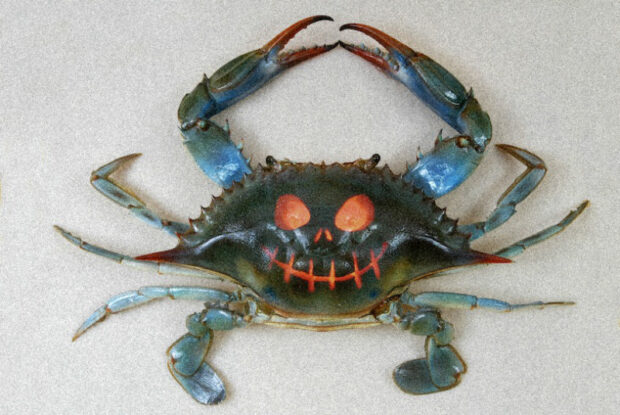I wrote this letter to one of my siblings at the start of the COVID lockdown here in the USA. It was a way for me to stay connected with my family by sharing some key memories from my early life in Maryland.
Story and digital collage by Luis Paredes
Do you know what a sink full of Chesapeake blue crabs sound like when you pour boiling water over them?
It sounds like Dad laughing.
Once his giggling settled down you’d hear the hiss of steam snaking its way out of every crevice, joint, eye stalk and orifice as dozens of crustaceans waved their legs, flipped themselves over and pounded their claws against aluminum in one massive convulsion. Sometimes, the heat caused eggs to burst from abdomens in a yellowish froth, segmented jaws to crack open, shells to split in half or legs to fly off and land wriggling on the linoleum floor.
After a few seconds, the contortions would slow as some of the crabs’ appendages would shrink inwards like skeletal hands closing into half formed fists while others would flatten out like limp rag dolls. After that, you might hear an occasional pop as the heat cooked the meat from the inside out, or perhaps a scrape of pincers against metal as a straggler tried to escape the basin. Then there’d be only a hissing silence from the sink and a gentle burbling from the second pot of water heating on the stove.
That’s when Mom would get to work: she’d lay out each crab on the counter, shower them with Old Bay seasoning, and occasionally hammer down an obstinate survivor. Then she’d dip each crab into the new boiling bath until the pot was full.
While cooking, the heat would paint over each crab’s iridescent blue armor with a new coat of menacing jack-o’-lantern orange or a sunburned red. The seasoning, gritty in your nostrils with notes of sea salt and paprika, added a speckled texture to the shells.
This transformation, depending on the size and number of blues inside, took fifteen or twenty minutes. To be sure they were safe to eat all mom would have to do is wait and watch; cooked crabs rise to the surface.
Then, with a pair of metal tongs, Mom would lift out each crab and place it onto a newspaper-covered platter, spacing each one out like playing cards; the weight and heat made the sheets crinkle and shrink as the mound of steaming shells grew taller.
Once the table was set, the three of us would sit, say a quick prayer, and snatch a crab from the pile. If we weren’t careful, we’d prick a palm against the spiky ridges running along the shells or hold onto a blistering-hot carapace for a few seconds too long. Either way, we’d rub our wound or suck the heat off of our fingertips before jumping back in and snapping a claw or splitting an abdomen to reveal tender, succulent white meat.
I’ll admit, sometimes it wasn’t pretty:
Every once in a while, after cracking open a shell, you’d find yourself staring at dollops of mustard-colored fat lining the interior dome, undercooked crab blood running black and gooey down your hands or bumpy grey masses of roe. If I encountered any “defect” like that, I’d push the crab to the side and never finish. Dad, noticing my discomfort, would snatch these pieces from my plate and eat them in front of me, usually without breaking eye contact.
By the end of dinner, the table would look like a bizarre war zone: crab mallets with whiskers of white flesh clinging to the sides, seafood crackers clinching a burst claw, chipped shells, and piles of dismembered legs and half eaten crabs (usually mine) splayed on and over plates.
Clean up was a mess. Luckily, I was too young to do the bulk of the work so I was able to walk away and let the adults do the wiping, scouring, and washing. The only thing left when they were through was the smell of crab that lingered in the air through the next day.
Those were some of the best weeknights of my life back when we lived in Maryland. I wasn’t always happy spending an entire day or night fishing and crabbing on a cold pier, but the delicious meals at the end made it all worth it.
I can’t remember if we ever did this together in Virginia or on a trip to Pax River, so I wanted to share this memory with you.
Now you can enjoy a slice of time from before you were born.
